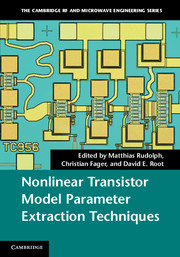Book contents
- Frontmatter
- Contents
- List of contributors
- Preface
- 1 Introduction
- 2 DC and thermal modeling: III–V FETs and HBTs
- 3 Extrinsic parameter and parasitic elements in III–V HBT and HEMT modeling
- 4 Uncertainties in small-signal equivalent circuit modeling
- 5 The large-signal model: theoretical foundations, practical considerations, and recent trends
- 6 Large and packaged transistors
- 7 Nonlinear characterization and modeling of dispersive effects in high-frequency power transistors
- 8 Optimizing microwave measurements for model construction and validation
- 9 Practical statistical simulation for efficient circuit design
- 10 Noise modeling
- Index
- References
9 - Practical statistical simulation for efficient circuit design
Published online by Cambridge University Press: 25 October 2011
- Frontmatter
- Contents
- List of contributors
- Preface
- 1 Introduction
- 2 DC and thermal modeling: III–V FETs and HBTs
- 3 Extrinsic parameter and parasitic elements in III–V HBT and HEMT modeling
- 4 Uncertainties in small-signal equivalent circuit modeling
- 5 The large-signal model: theoretical foundations, practical considerations, and recent trends
- 6 Large and packaged transistors
- 7 Nonlinear characterization and modeling of dispersive effects in high-frequency power transistors
- 8 Optimizing microwave measurements for model construction and validation
- 9 Practical statistical simulation for efficient circuit design
- 10 Noise modeling
- Index
- References
Summary
Introduction
In wireless handset design, specifically power amplifiers (PAs), there is constant pressure to improve time-to-market while maintaining high yields. To meet these demands, designers need to evaluate current design practices and identify areas for improvement. Presently, some PA designers spend a great deal of time bench-tuning to optimize circuits. Because this is very time consuming, the main focus is obtaining the best “nominal” performance, and process variation is generally an afterthought. Frequently, new circuit topologies are implemented and minimal sample sizes are evaluated (often on a single wafer) leading to “one-wafer wonder” results.
Unfortunately, as the design is run over many wafers, normal process variations take their toll degrading the initial “hero” performance and, in the extreme case, lead to unacceptable yields. These variations are often blamed on the starting material or the fabrication process but, in reality, are due to expected process variations.
Including process statistics in the simulation phase can greatly reduce the occurrence of these frustrating events. To date, the implementation of statistical simulations in microwave designs (and III–V designs, specifically) has been limited, even though it is commonplace in silicon (Si) digital or analog-mixed signal design [1–6].
What are the barriers? The first is that methodology used in the Si design community is usually centered on inherently time-consuming Monte Carlo (MC) simulations [4–7]. While necessary for most Si designs, where neighboring device mismatches are critical, the additional complexity and added simulation time makes it “unfit” for III–V designs where devices are large and wafer turnround time is short (weeks compared to months).
- Type
- Chapter
- Information
- Nonlinear Transistor Model Parameter Extraction Techniques , pp. 287 - 317Publisher: Cambridge University PressPrint publication year: 2011
References
- 3
- Cited by



